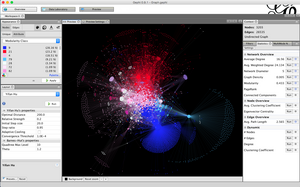Gephi (/ˈɡɛfi/ GE-fee[4][5]) is an open-source network analysis and visualization software package written in Java on the NetBeans platform.[6]
 | |
 | |
| Developer(s) | Mathieu Bastian, Eduardo Ramos Ibañez, Mathieu Jacomy, Cezary Bartosiak, Sébastien Heymann, Julian Bilcke, Patrick McSweeney, André Panisson, Jérémy Subtil, Helder Suzuki, Martin Skurla, Antonio Patriarca |
|---|---|
| Initial release | 31 July 2008[1] |
| Stable release | 0.10.1[2] / 17 January 2023 |
| Repository | |
| Written in | Java, OpenGL |
| Operating system | Linux, Windows, macOS |
| Platform | NetBeans |
| Size | 121.1 MB |
| Available in | English, Chinese, Czech, French, German, Japanese, Portuguese (Brazil), Russian, Spanish, |
| Type | Visualization |
| License | GNU General Public License, Common Development and Distribution License |
| Website | gephi |

History
editInitially developed by students of the University of Technology of Compiègne (UTC)[7] in France, Gephi has been selected for the Google Summer of Code in 2009, 2010, 2011, 2012, and 2013.
Its last version, 0.10.1 has been launched in 2023. Previous versions are 0.6.0 (2008), 0.7.0 (2010), 0.8.0 (2011), 0.8.1 (2012), 0.8.2 (2013),[8] 0.9.0 (2015),[9] 0.9.1 (2016)[10] and 0.9.2 (2017).[11]
The Gephi Consortium, created in 2010, is a French non-profit corporation which supports development of future releases of Gephi. Members include SciencesPo, Linkfluence, WebAtlas, and Quid.[12] Gephi is also supported by a large community of users, structured on a discussion group[13] and a forum[14] and producing numerous blogposts, papers and tutorials.[15]
In November 2022, a lightweight web version of Gephi, Gephi lite, was announced.[16]
Applications
editGephi has been used in a number of research projects in academia, journalism and elsewhere, for instance in visualizing the global connectivity of New York Times content[17] and examining Twitter network traffic during social unrest[18][19] along with more traditional network analysis topics.[20] Gephi is widely used within the digital humanities (in history,[21] literature, political sciences, etc.), a community where many of its developers are involved.
Gephi inspired the LinkedIn InMaps[22] and was used for the network visualizations for Truthy.[23]
See also
edit- Graph (discrete mathematics)
- Graph drawing
- Graph theory
- Graph (data structure)
- Social network analysis software
- File formats
- Related software
